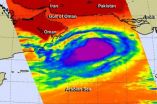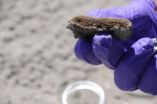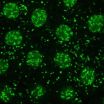(Press-News.org) Tropical Cyclone Nanauk is holding its own for now as it moves through the Arabian Sea. NASA's Aqua satellite took its cloud top temperatures to determine its health.
In terms of infrared data viewing tropical cyclones, those with the coldest cloud top temperatures indicate that a storm is the most healthy, most robust and powerful. That's because thunderstorms that have strong uplift are pushed to the top of the troposphere where temperatures are bitter cold. Infrared data, such as that collected from the Atmospheric Infrared Sounder (AIRS) instrument that flies aboard NASA's Aqua satellite can tell those temperatures. If AIRS data shows that cloud top temperatures are near or colder than -63 Fahrenheit (-53 Celsius), that indicates strong thunderstorms high up in the troposphere. According to research with AIRS data, thunderstorms with cloud top temperatures that high are likely to generate heavy rainfall.
So, when Aqua flew over Tropical Cyclone Nanauk on June 12 at 9:11 UTC (5:11 a.m. EDT) temperatures of the many thunderstorms that circled the center of Nanauk were that cold or colder. The AIRS image also showed a band of thunderstorms that almost completely circled the storm, with the exception of the southwestern quadrant. Nanauk also seemed to fill up the northern part of the Arabian Sea.
On June 12 at 1500 UTC (11 a.m. EDT), Tropical Cyclone Nanauk was located approximately 425 nautical miles (489 miles/787 km) southeast of Muscat, Oman, near 18.3 north latitude and 63.4 east longitude. Nanauk was moving to the west at 10 knots (11.5 mph/18.5 kph). Maximum sustained winds remained near 55 knots (63.2 mph/102 kph).
Nanauk faces several challenges over the next couple of days, according to the Joint Typhoon Warning Center. Three factors will weaken the system quickly: increasing vertical wind shear, dry air moving into the tropical cyclone and cooler sea surface temperatures.
Nanauk is forecast to continue tracking west-northwestward over the next day or two before succumbing to a more hostile environment.
INFORMATION:
NASA takes Tropical Cyclone Nanuak's temperature
2014-06-12
ELSE PRESS RELEASES FROM THIS DATE:
Findings point toward one of first therapies for Lou Gehrig's disease
2014-06-12
CORVALLIS, Ore. – Researchers have determined that a copper compound known for decades may form the basis for a therapy for amyotrophic lateral sclerosis (ALS), or Lou Gehrig's disease.
In a new study just published in the Journal of Neuroscience, scientists from Australia, the United States (Oregon), and the United Kingdom showed in laboratory animal tests that oral intake of this compound significantly extended the lifespan and improved the locomotor function of transgenic mice that are genetically engineered to develop this debilitating and terminal disease.
In humans, ...
Scientists identify Deepwater Horizon Oil on shore even years later, after most has degraded
2014-06-12
Years after the 2010 Deepwater Horizon Oil spill, oil continues to wash ashore as oil-soaked "sand patties," persists in salt marshes abutting the Gulf of Mexico, and questions remain about how much oil has been deposited on the seafloor. Scientists from Woods Hole Oceanographic Institution and Bigelow Laboratory for Ocean Sciences have developed a unique way to fingerprint oil, even after most of it has degraded, and to assess how it changes over time. Researchers refined methods typically used to identify the source of oil spills and adapted them for application on a ...
Anti-dsDNA, surface-expressed TLR4 and endosomal TLR9 cooperate to exacerbate lupus
2014-06-12
Systemic lupus erythematosus (SLE) is a complicated multifactorial autoimmune disease influenced by many genetic and environmental factors. The hallmark of systemic lupus erythematosus (SLE) is the presence of high levels of anti-double-stranded DNA autoantibody (anti-dsDNA) in sera. In addition, greater infection rates are found in SLE patients and higher morbidity and mortality usually come from bacterial infections. Deciphering interactions between the susceptibility genes and the environmental factors for lupus complex traits is challenging and has resulted in only ...
Protein anchors help keep embryonic development 'just right'
2014-06-12
The "Goldilocks effect" in fruit fly embryos may be more intricate than previously thought. It's been known that specific proteins, called histones, must exist within a certain range—if there are too few, a fruit fly's DNA is damaged; if there are too many, the cell dies. Now research out of the University of Rochester shows that different types of histone proteins also need to exist in specific proportions. The work further shows that cellular storage facilities keep over-produced histones in reserve until they are needed.
Associate Professor of Biology Michael Welte ...
Penn study describes new models for testing Parkinson's disease immune-based drugs
2014-06-12
PHILADELPHIA - Using powerful, newly developed cell culture and mouse models of sporadic Parkinson's disease (PD), a team of researchers from the Perelman School of Medicine at the University of Pennsylvania, has demonstrated that immunotherapy with specifically targeted antibodies may block the development and spread of PD pathology in the brain. By intercepting the distorted and misfolded alpha-synuclein (α-syn) proteins that enter and propagate in neurons, creating aggregates, the researchers prevented the development of pathology and also reversed some of the ...
Viral infections, including flu, could be inhibited by naturally occurring protein
2014-06-12
PITTSBURGH, June 12, 2014 – By boosting a protein that naturally exists in our cells, an international team of researchers led by the University of Pittsburgh Cancer Institute (UPCI), partner with UPMC CancerCenter, has found a potential way to enhance our ability to sense and inhibit viral infections.
The laboratory-based discovery, which could lead to more effective treatments for viruses ranging from hepatitis C to the flu, appears in the June 19 issue of the journal Immunity. The research is supported by the National Institutes of Health.
"Despite remarkable advances ...
African-Americans respond better to first-line diabetes drug than whites
2014-06-12
Washington, DC—African Americans taking the diabetes drug metformin saw greater improvements in their blood sugar control than white individuals who were prescribed the same medication, according to a new study published in the Endocrine Society's Journal of Clinical Endocrinology & Metabolism (JCEM).
An estimated 29 million Americans have diabetes. African Americans are twice as likely to be diagnosed with diabetes as whites and have a higher rate of complications such as kidney failure, according to the U.S. Department of Health and Human Services' Office of Minority ...
Brain power
2014-06-12
VIDEO:
Real-time movie of changes in total hemoglobin in the brain during stimulation. The initial blush of the brain is followed quickly by dilation (red) of arteries on the brain's surface....
Click here for more information.
New York, NY—June 12, 2014—In a new study published online in the Journal of the American Heart Association June 12, 2014, researchers at Columbia Engineering report that they have identified a new component of the biological mechanism that controls ...
Time-lapse study reveals bottlenecks in stem cell expansion
2014-06-12
A time-lapse study of human embryonic stems cells has identified bottlenecks restricting the formation of colonies, a discovery that could lead to improvement in their use in regenerative medicine.
Biologists at the University of Sheffield's Centre for Stem Cell Biology led by Professor Peter Andrews and engineers in the Complex Systems and Signal Processing Group led by Professor Daniel Coca studied human pluripotent stem cells, which are a potential source of cells for regenerative medicine because they have the ability to produce any cell type in the body.
However, ...
Synchronized brain waves enable rapid learning
2014-06-12
CAMBRIDGE, MA -- The human mind can rapidly absorb and analyze new information as it flits from thought to thought. These quickly changing brain states may be encoded by synchronization of brain waves across different brain regions, according to a new study from MIT neuroscientists.
The researchers found that as monkeys learn to categorize different patterns of dots, two brain areas involved in learning — the prefrontal cortex and the striatum — synchronize their brain waves to form new communication circuits.
"We're seeing direct evidence for the interactions between ...




